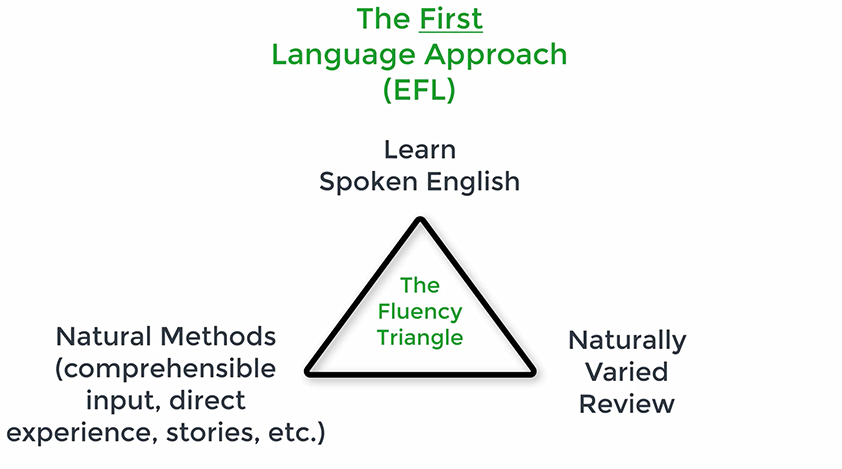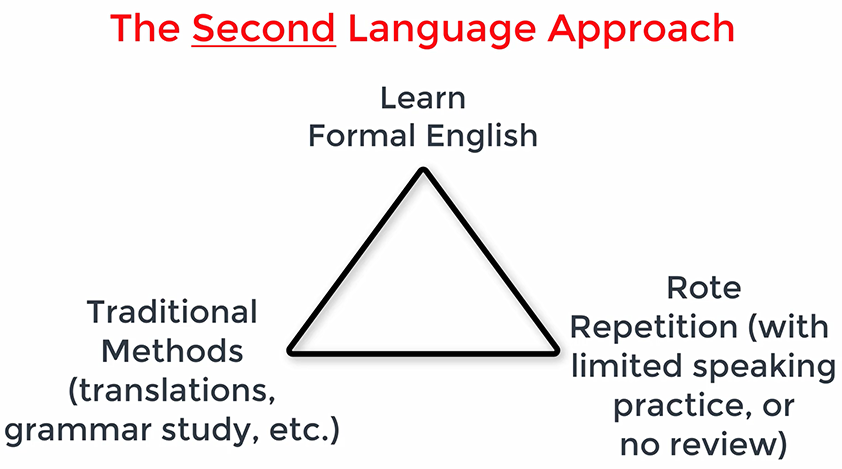5 English Language Learning Methods: The Best Way to Guarantee Fluency

Table of Contents:
- The 5 Most Common Methods of Learning English
- 1. The English as a FIRST Language Method
- 2. English Language Learning Software & Apps
- 3. ESL Lessons In Your Native Language
- 4. ESL Lessons In English
- 5. Test Prep Courses
- There Is Only One Path to Fluency
Imagine a colleague asks you – in English – about life outside of work.
You’ve had English classes, understand the question, and want your reply to make a good impression.
But when you try to explain, you stumble and pause. You might be unsure about pronunciation, or worried about making a mistake. Or maybe the right words just don’t come to you.
So you can’t express yourself as fluently as you’d like.
Today’s post is for learners who know a lot of English but still struggle to speak.
You’ll learn about the most common English language learning methods, see why it’s not your fault if you can’t yet express yourself fluently, and discover the one method that guarantees comfortable, confident spoken English.
Let’s get started!
The 5 Most Common Methods of Learning English
There are two main categories of teaching methods that we’ll look into:
- English as a FIRST Language – EFL: This is the method that I use for my Fluent for Life program
- English as a SECOND Language – ESL: This is the method most classes and programs use, including the following:
- Apps & Software
- Native Tongue Lessons (like English taught in Spanish or Chinese)
- Lessons in English
- Test Prep Courses
Here’s a quick overview of each.
<?php
class WFACP_Dequeue_Theme_Assets {
/*
* Add Url Path under theme folder which are enqueue on the page
* */
private $enqueue_js_css = [
];
public function __construct() {
/*
* If Dequeue All theme assets then we can use this hook
*/
add_action( 'wfacp_after_checkout_page_found', [ $this, 'remove_action' ] );
/*
* If user want to enqueue specific js and css file then can use below hoo
*/
add_filter( 'wfacp_css_js_deque', [ $this, 'js_css_enqueue' ], 10, 4 );
/*
* Dequeue the Upload folder css if cache file served
*/
add_filter( 'wfacp_css_js_removal_paths', [ $this, 'css_js_removal_paths' ], 10, 2 );
/*
* Add Custom Css if any other css need to be add
*
*/
add_action( 'wfacp_internal_css', [ $this, 'add_css' ] );
}
public function remove_action() {
if ( ! function_exists( 'wfacp_template' ) ) {
return;
}
$instance = wfacp_template();
if ( is_null( $instance ) || ! method_exists( $instance, 'remove_theme_styling' ) ) {
return;
}
remove_filter( 'wfacp_css_js_deque', [ $instance, 'remove_theme_styling' ], 10, 4 );
}
public function js_css_enqueue( $bool, $path, $url, $current ) {
if ( ! is_array( $this->enqueue_js_css ) || count( $this->enqueue_js_css ) == 0 ) {
return $bool;
}
foreach ( $this->enqueue_js_css as $key => $val ) {
if ( false !== strpos( $url, $val ) ) {
return false;
}
}
return true;
}
public function css_js_removal_paths( $paths ) {
$paths[] = 'uploads/wp-scss-cache/pix-woo-style.css';
return $paths;
}
public function add_css(){
echo "<style>";
echo 'body #wfacp-sec-wrapper .wfacp_main_form #payment .payment_methods li>.input-radio {min-width: 1px !important;width: 16px !important;margin: 0 10px 0 0 !important;}';
echo "</style>";
}
function strpos_arr( $haystack, $needle ) {
if ( ! is_array( $needle ) ) {
$needle = array( $needle );
}
foreach ( $needle as $what ) {
if ( ( $pos = strpos( $haystack, $what ) ) !== false ) {
return $pos;
}
}
return false;
}
}
new WFACP_Dequeue_Theme_Assets();1. The English as a FIRST Language Method

Think about how parents teach children to speak.
Children can’t translate. Or follow grammar rules. Or study textbooks.
So the ONLY WAY children can learn their native language is with UNDERSTANDABLE MESSAGES.
This is the same foundation of learning English as a first language (EFL). And the best part is — you’ve already used it successfully! It’s how you became fluent in your native language!
How Does It Work?
English as a first language (EFL) uses your brain’s natural ability to recognize patterns and solve problems when it can understand messages.
Three elements make this possible:
- Examples of real, spoken English
- Comprehensible input (understandable messages), like stories and visual examples
- Naturally varied review, which helps you review without boredom, and build fluency automatically

This is how I teach at EnglishAnyone.
The goal is for you to connect phrases, expressions, and grammar with REAL SITUATIONS, all in English…
Because how you learn is how you speak!
Nothing stops you from UNDERSTANDING when you learn English as a first language. You connect directly with the language. So you don’t need to think about grammar or translations when you SPEAK:

But when you use translations or try to memorize grammar rules, you create “blocks” to understanding that cause you to hesitate, worry and struggle in conversations.

See why so many learners forget their words or have to organize sentences in their heads before they speak?
My job is to make English understandable so you can develop fluency automatically.
Here are just some of the benefits of learning English as a first language:
It’s way more fun and enjoyable
- You discover the language naturally (so you remember more)
- Lessons are simple and easy to understand (so you stay motivated)
- You learn “real” English the same way natives do
- Lessons are always changing and new (less repetitive)
But What About Speaking? And Do I Still Need a Practice Partner?
Well, here’s the most exciting part about learning English as a first language:
Researchers like Dr. Stephen Krashen confirmed that fluency is the RESULT of understanding, not speaking practice.
Here are three important things these researchers found:
1. Repeating Words and Phrases Is Not “Practice”
Communication is dynamic. This means you can’t prepare for conversations by memorizing and “practicing” words and phrases like you practice a song on an instrument.
You must be able to understand and respond quickly. So your time is better spent getting as many understandable lessons as possible, instead of repeating vocabulary in a mirror.
2. The Real “Practice” that Builds Fluency Comes From Understandable Lessons
Even in conversations, it’s not what you say, but what the other person says that improves your understanding and fluency. So the best “practice” for learning to speak is, again, more input.
This is great news, especially if you are learning on your own, without anyone to speak with. As long as you get the right input, you can actually improve without saying a word!
3. You Can Hurt Your Progress If You Speak Before You’re Ready
Researchers discovered that there’s a “filter” that prevents your brain from understanding and communicating when you feel nervous.
This is why so many learners can have a large vocabulary, but only feel confident saying simple sentences. If you’ve ever had to speak before you felt ready, you know how painful this can be.
So, linguists like Dr. Krashen actually recommend you stay silent as you learn until you really feel comfortable. As he noted, “We acquire language in one way and only one way: When we get comprehensible input in a low-stress environment.”
Here’s Even More Proof That You Should Learn English As A First Language If Your Goal Is Fluency
A study was done on Japanese students learning English.
Researchers compared:
- Skill-based learning (ESL), where students memorize vocabulary, grammar rules, and translations.
- Comprehensible input learning (EFL), where students listened to stories and read books they could understand.
Group A spent seven hours per week studying textbooks in the classroom.
This was 126 hours of class time per semester, and their fluency improved on average by only 0.05 points per hour of class time.
Group B spent only one hour per week getting comprehensible input in the classroom.
They had only 18 hours of class time per semester, and gained four times more points in fluency per hour!
When you can understand messages from day one, your fluency builds automatically…
All without studying translations or memorizing rules, and even if you don’t speak!
No other method takes advantage of the way your brain wants to learn languages.
So using this method, you CAN quickly become a fluent English speaker!
Pros:
- Lessons are easy to understand (and fun)
- Builds your fluency from day one
- You learn REAL ENGLISH as a native would
- Guaranteed to get you to fluent (it’s how you got fluent in your language)
- Scientifically proven to be the only way we acquire language
- No pressure to speak before you’re ready to
- Works for everyone
- No boring grammar books
- Uses visual examples and stories instead of flashcards or drills
- Review stays fresh so you build fluency without stress or boredom
Cons:
- Very difficult without a teacher or a well-designed learning program
- EnglishAnyone’s courses are the only ones following this approach
Fluent for Life GUARANTEES English fluency for intermediate to advanced English learners.
If you KNOW a lot of English, but struggle to SPEAK…
2. English Language Learning Software & Apps

These programs typically break down vocabulary and grammar in a fun, gamified way, using short lessons and interactive exercises.
Generally, apps focus on:
- Translations
- Word lists
- Definitions
- Grammar rules
- Dialogues
They’re often free to try, easy to use, and you can start learning from pretty much anywhere with an Internet connection.
Teaching styles include a combination of reading, writing, listening, and sometimes speaking exercises. Some apps even allow you to chat with a tutor – although this generally is an additional expense.
While it’s easy to get started, the biggest problem with apps is that they don’t teach the real language that natives speak. This is why many learners complain that they still can’t understand natives, communicate naturally, or have conversations even after weeks of daily app lessons.
Many apps use multiple-choice questions with single correct answers. Not only does this prevent you from becoming a dynamic, spontaneous speaker… But after a while, the format and lessons can become repetitive and boring.
Another big issue is that apps can leave you with more questions than answers — leading to confusion and frustration as you wonder if you’re saying something correctly, or if vocabulary can be used in other ways.
If you want to get beyond basic skills, you’ll probably need a teacher to explain things to you (and in your native language), making fluency even harder to develop.
If you want to use the most effective method to learn and speak English fast, this isn’t it.
Pros:
- Free to start
- Can be fun initially
- Doesn’t take a lot of time
- Can be used to learn English anywhere
- Easy to use
Cons:
- Low chance of learning to speak English confidently
- Not ideal for intermediate or advanced English learners
- Lessons can lead to confusion
- Unlikely to develop fluency
- Can become very repetitive
- Easy to quit because there’s no commitment, delaying your progress
3. ESL Lessons In Your Native Language

Remember, how you LEARN is how you SPEAK. So, learning grammar rules and memorizing translations means that you have to think about these same rules and translations again when you speak.
While your native language can initially help you learn some English words and concepts, and you may feel more comfortable with this support, your speech will most likely suffer.
Unfortunately, most language learning courses teach this way in the classroom, and even online. And they tend to be very frustrating because teachers can give you translations, instead of thoughtful lessons that make the language understandable all in English.
Much like apps, these classes involve memorizing:
- Word lists of formal English, not the slang, idioms, and real expressions native use
- Definitions
- Translations
- Grammar rules
But they distance you from native culture, and you’re less exposed to the way native English speakers talk. So, you will have to unlearn many habits, like translating in your head or practicing speaking to overcome the barriers these lessons build.
And, of course, because these lessons are really the opposite of the way your brain wants to learn languages, you need a HUGE amount of mental effort and willpower to continue learning.

Pros:
- Feels more comfortable at first because you can rely on your native language
- Allows you to learn the basics of the language (reading, writing, understanding)
- Usually guided by an instructor who can answer your questions
- You have access to a community of students with in-person classes
Cons:
- Prevents you from developing fluency
- Doesn’t help you feel confident in real conversations
- Courses and books can demotivate you
- Learning can last years without results
- Often boring and repetitive
- Dialogues are rarely how natives speak
4. ESL Lessons In English

These classes can be much better for you than learning English in your native language because the content is all in English.
But these lessons follow the same kinds of traditional approaches that cause you to hesitate when you speak.
Even live lessons with native teachers – which many learners believe they need – can fail to develop fluency, teach vocabulary that natives don’t really use, give slow examples instead of natural ones, and lack the varied examples and review you need from many different native speakers.
Immersion in a language is also great if you understand everything. But most people don’t, which is why a friend of mine who tried learning Spanish in Mexico for a year returned to the US only a slightly better speaker.
At worst, you’re trapped in classes that force you to:
- Learn the names of grammar rules, instead of how to use correct grammar automatically
- Study a lot of words, but develop only a passive vocabulary that you can’t recall in conversations
- Practice repeating unnatural phrases, rather than developing fluency
- Worry that you’ll be called on to speak before you’re ready
As with the other second language learning methods, you might develop a basic understanding of English, but FLUENCY will likely remain out of reach.
Remember that even lessons in English don’t guarantee you’ll understand like a native. And only when you truly understand the language do you gain the confidence to speak:

Pros:
- More effective than learning English in your native language
- Can be more immersive and fun, especially in-person
- Greater opportunity to learn about the culture if you’re in an English-speaking country, although you can pay a heavy cost in time and money
- Helps you learn the basics of English (reading, writing, understanding)
- Often led by instructors who can answer your questions
- Can expose you to more natural dialogue
Cons:
- Still relies on traditional methods like grammar study, translations, and memorization
- Doesn’t guarantee you will SPEAK fluently
- Likely won’t inspire confidence in real conversations
- Courses and books can demotivate you
- Learning can last years without results
- Can still be boring and repetitive
5. Test Prep Courses

The main focus of these programs is the test, not fluency.
So you may learn how to answer questions on written exams – or during interviews given by instructors with clear voices – but you won’t likely be prepared for real-life English communication.
Many of the English learners I help find me after getting good scores on tests but still struggling to get jobs or promotions because of poor speech.
These courses can also be taught in English, or in your native language. You can also study by yourself with workbooks and online lessons.
But many schools can require a lot of time, and can cost hundreds of dollars per week.
Remember, the biggest problem with ESL methods is that they might teach you the language, but they prevent you from developing speech. So the only good reason to take a test-prep course is that you need a good score for a school or job.
Pros:
- Very focused and time intensive
- Can be done from home or in a classroom
- Can help you prepare for a standardized English language test
Cons:
- Can be very expensive
- The benefits of communication can be limited
- Often, you don’t learn “real” English
- Not the most effective way to learn a language, if your goal is fluency
There Is Only One Path to Fluency
I know how frustrating it can be to study a language for years and never achieve fluency.
Even immersion isn’t the secret to success that most people think it is. Learners who’ve lived in English-speaking countries for years but still can’t speak know this very well.
But everything can change the day you start learning English as a FIRST language.
This is exactly what I discovered when I finally began getting fluent in Japanese after failing to learn different languages for 15 years.
And this is why I’ve spent the past 20 years helping English learners understand English like natives.
It’s both the fastest way to improve and the only guaranteed way to develop confident speech. Fluent speakers do very well on English tests, too!
So if you don’t want to spend years learning grammar rules and memorizing translations, but you DO want to get fluent — check out Fluent for Life.
Additional English Language Learning Articles For You:
